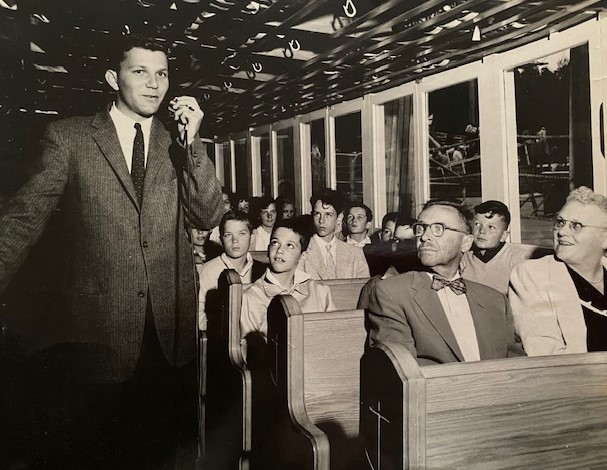Raymond A. "Chip" Mason's Early Start: A rare image from the past
Karen Williams Laufer of Williamsburg, Virginia, recently donated a rare and delightfully candid photograph of alumnus, Raymond A. “Chip” Mason, Class of ’59 to the Raymond A. Mason School of Business at William & Mary. The picture was taken by her father and master photographer, Thomas Williams, during the 1950s.
William & Mary established the Master of Business Administration (MBA) Program in 1966. In 1968 the Department of Business became the School of Business, and in 1971, the University's Board of Visitors approved the addition of the Bachelor of Business Administration (BBA) undergraduate degree.
In November 2005, the business school was named for Raymond A. "Chip" Mason, former Chairman, President, and Chief Executive Officer of the Baltimore-based investment firm Legg Mason, which he established at the sprightly age of 25.
The donated photograph captures a bygone era when everyday attire captured men donning coats and ties. On the back of the picture, the following description is penned: Chip Mason. William & Mary student interpreter. Jamestown tour boat. Aboard a small cruiser, speaking into his microphone, the image could very well be a vignette from Rod Serling’s “The Twilight Zone.” The passengers, mostly school kids, look to be sitting attentively in shipboard pews, enrapt with what Chip is describing. The quality of the image reveals another story as well.
Thomas Williams, the man taking the picture, was the prevailing photographer about town.
After graduating from the Art Institute of Pittsburgh, Mr. Williams volunteered for the Navy shortly after Pearl Harbor. He was stationed at Camp Peary and set up the base's photography laboratory. During this time, the Navy loaned him to the Colonial Williamsburg Foundation to record the restoration of historic landmarks because the organization did not have a staff photographer.
While in the Navy, Mr. Williams was sent to the Norfolk Naval Base to work on a secret project: producing relief maps that were used to plan the Normandy invasion. He translated aerial photographs to depict where buildings and roads were to assist troops on the battlefield.
When the war ended, Colonial Williamsburg asked him to come aboard to construct a photography section, where he worked for nine years as the foundation’s first and only photographer. He illustrated five books and took thousands of negatives that portrayed progress of the restoration. His works appeared in many magazines, including National Geographic, Life, and Better Homes and Gardens.
Mr. Williams then became the official photographer for William & Mary, working there for 35 years. "Tom Williams was a master photographer. He covered all of our major events at the school, and his photographs reflected a strong, creative talent," said Davis Y. Paschall, former president of the university.
He was later hired by Anheuser-Busch to record construction of the brewery and Busch Gardens. Karen remembers her father going around the undeveloped land in a golf cart with Mr. Anheuser-Busch, surveying the land soon to be transformed into a theme park. He projected Colonial Williamsburg was in for some serious competition in terms of tourism. In 1955, Mr. Williams opened his own photography business in Williamsburg. His daughter was often the subject of many beautiful black and white compositions with the colonial area as the backdrop. Karen laughs as she really wasn’t that keen on being in front of the camera, but her father knew just how to get the right look, the spontaneous expression.
"My father was very modest about his work. He never advertised; all of his business was due to word-of-mouth. His biggest concern was that every photo represented the best he could do.”
Karen said it was important for him to keep his fees reasonable so people could enjoy his art, and he was known for donating paints and canvasses to aspiring artists.
Now, all these years later, shifting through the last of her father’s portfolios and leftover prints, Karen wishes to preserve the legacy of Tom Williams, and that of Raymond A. “Chip” Mason. The picture, which will reside in the Dean’s Suite is a testament to humble beginnings and is a reminder that we all have to start somewhere. Whether in the world of business or art, one must hone and craft skills to build success.
As an interpreter, Chip polished his soft skills by speaking with people and building a positive rapport. What may have seemed like an insignificant side hustle as a student interpreter actually depicts important interpersonal characteristics for those currently in business or pursuing a career in business. You can have all the book knowledge and data in the world, but you also have to be personal and willing to step out and take charge. Success isn’t just graduating with a degree. Success is having a plan in place and preparing for the day after graduation.

